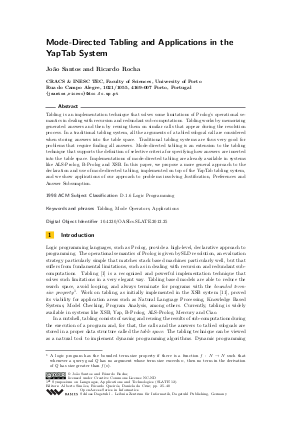Mode-Directed Tabling and Applications in the YapTab System
Authors João Santos, Ricardo Rocha
-
Part of:
Volume:
1st Symposium on Languages, Applications and Technologies (SLATE 2012)
Part of: Series: Open Access Series in Informatics (OASIcs)
Part of: Conference: Symposium on Languages, Applications and Technologies (SLATE) - License:
 Creative Commons Attribution-NonCommercial-NoDerivs 3.0 Unported license
Creative Commons Attribution-NonCommercial-NoDerivs 3.0 Unported license
- Publication Date: 2012-06-21
File

PDF
OASIcs.SLATE.2012.25.pdf
- Filesize: 393 kB
- 16 pages
Document Identifiers
Subject Classification
Keywords
- Tabling
- Mode Operators
- Applications
Metrics
- Access Statistics
-
Total Accesses (updated on a weekly basis)
0Document
0Metadata
Abstract
Tabling is an implementation technique that solves some limitations of Prolog's operational semantics in dealing with recursion and redundant sub-computations. Tabling works by memorizing generated answers and then by reusing them on similar calls that appear during the resolution process. In a traditional tabling system, all the arguments of a tabled subgoal call are considered when storing answers into the table space. Traditional tabling systems are thus very good for problems that require finding all answers. Mode-directed tabling is an extension to the tabling technique that supports the definition of selective criteria for specifying how answers are inserted into the table space. Implementations of mode-directed tabling are already available in systems like ALS-Prolog, B-Prolog and XSB. In this paper, we propose a more general approach to the declaration and use of mode-directed tabling, implemented on top of the YapTab tabling system, and we show applications of our approach to problems involving Justification, Preferences and Answer Subsumption.
Cite As Get BibTex
João Santos and Ricardo Rocha. Mode-Directed Tabling and Applications in the YapTab System. In 1st Symposium on Languages, Applications and Technologies. Open Access Series in Informatics (OASIcs), Volume 21, pp. 25-40, Schloss Dagstuhl – Leibniz-Zentrum für Informatik (2012)
https://doi.org/10.4230/OASIcs.SLATE.2012.25
BibTex
@InProceedings{santos_et_al:OASIcs.SLATE.2012.25,
author = {Santos, Jo\~{a}o and Rocha, Ricardo},
title = {{Mode-Directed Tabling and Applications in the YapTab System}},
booktitle = {1st Symposium on Languages, Applications and Technologies},
pages = {25--40},
series = {Open Access Series in Informatics (OASIcs)},
ISBN = {978-3-939897-40-8},
ISSN = {2190-6807},
year = {2012},
volume = {21},
editor = {Sim\~{o}es, Alberto and Queir\'{o}s, Ricardo and da Cruz, Daniela},
publisher = {Schloss Dagstuhl -- Leibniz-Zentrum f{\"u}r Informatik},
address = {Dagstuhl, Germany},
URL = {https://drops.dagstuhl.de/entities/document/10.4230/OASIcs.SLATE.2012.25},
URN = {urn:nbn:de:0030-drops-35123},
doi = {10.4230/OASIcs.SLATE.2012.25},
annote = {Keywords: Tabling, Mode Operators, Applications}
}
